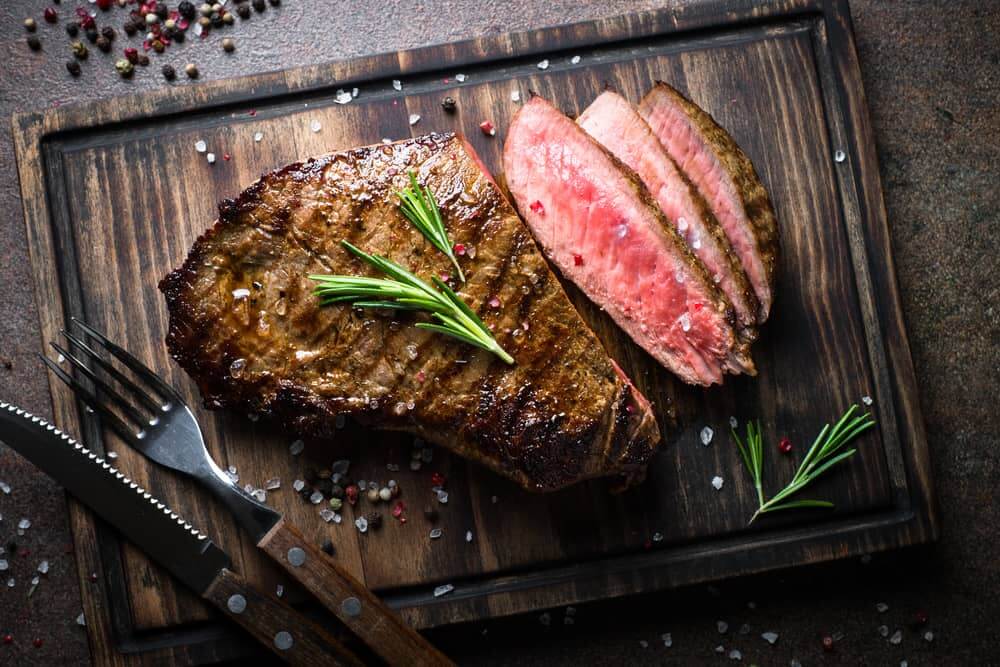
Steak is a hotly-debated food. Is it too fatty and too cholesterol-filled to be healthy for the heart? Or do all the minerals and vitamins it includes outweigh the other stuff? Contrary to popular belief, red meat has several health benefits, but most people just aren’t aware of them.
Ribeye is, arguably, one of the most delicious steak cuts out there. It’s marbled with just the right amount of fat to keep it tender and juicy without becoming chewy. It has rich flavors and beautiful coloring and cooks just as good in a frying pan as it does on the grill. But is it healthy for you? Let’s dig in.
Nutritional Value of Ribeye
A serving size of steak should be about 3 ounces. We know, that’s not a lot for us steak enthusiasts. But to determine the nutritional value of a ribeye, we’re going to stick with it. In just 3 ounces of ribeye, you can expect the following:
- Calories: 248
- Saturated fat: 8 grams
- Trans fat:3 grams
- Polyunsaturated fat:9 grams
- Monounsaturated fat: 9 grams
- Cholesterol: 68 mg
- Sodium: 46 mg
- Protein: 20 mg
- Potassium: 221 mg
- Carbs: 0 g
Since the above information probably doesn’t mean a lot to the average person who isn’t a whiz with nutrition labels, we’re going to break it down a little further, so you can see what’s beneficial (and not so beneficial) to your health.
The Iffy Bad Fats
One of the biggest concerns people have about red meat is all the fat it contains. Ribeye is a fatty piece of steak and, yes, it’s true that there’s some “bad fat,” also known as saturated fat and trans fat, inside. Saturated and trans fats are linked to some heart-unhealthy stuff, like high cholesterol and lipid levels in the body. If you’re concerned about saturated fat content in your steak, you can always cook it to well-done to eliminate some of the fat or look for ribeye cuts with minimal marbling.
Cholesterol
Another issue with red meats is cholesterol. Cholesterol is a fatty substance that lives in your bloodstream and helps your body with several processes, like digestion and hormone production. Your body makes all it needs, but many foods also contain it, which could push your levels to an unhealthy mark.
Fortunately, if you watch your cholesterol intake in your diet and exercise regularly, it probably won’t affect you much. Keep your ribeye portion to three ounces and limit your red meat intake to keep your cholesterol levels consistent.
Sodium
Sodium is a naturally-occurring substance in most meat, even chicken. It sometimes gets a bad rep because of its link to heart disease, but the truth is that, when you keep an eye on sodium in your diet and don’t go overboard, it’s probably not an issue. In fact, most steaks have less sodium in 3 ounces than chicken does, and yes, that includes ribeye!
The Great
Good Amount of Protein, No Carbs
Most meats are good sources of protein, and the ribeye is no exception. Although it doesn’t have more protein than chicken and fish, it does contain a good amount for you to add into a regular diet. Experts suggest getting at least 46 to 56 grams of protein if you’re not very active, and more if you are active or exercise regularly. For just 3 ounces of ribeye, you’ll get 20 grams of protein into your day.
On the flip side of that is that ribeye and other steaks contain zero carbohydrates. Carbs are necessary for your body to use energy properly but consuming too many carbs can lead to weight gain, high blood sugar levels, and an increased risk of diabetes.
Good Fats
Ribeye does contain fat, but some of the fat content is also good fats. Monounsaturated and polyunsaturated fats can both lower bad cholesterol, also known as LDL, in your body!
Potassium
Potassium can help lower sodium in the body, regulate blood pressure, and prevent things like infertility and heart disease. Unfortunately, potassium isn’t easy to find in many foods, but red meat is one you will find it in. In just one serving of ribeye, you’ll get more than 200 mg, which is the same as about half a banana. Add some other potassium-rich foods to your diet, like beans, avocado, and tomatoes, and you’ll likely get your recommended intake.
Conclusion: Is Ribeye Steak Healthy?
Most foods have their pros and cons, so we shouldn’t expect red meat to be perfect. However, ribeye tends to have a lot of misconceptions surrounding its nutritional value. It actually has a lot of health benefits that we tend to overlook.
Are you ready to order ribeye online? Chicago Steak Company has a selection of Premium Angus ribeye, USDA Prime ribeye, and our top-of-the-line American Wagyu ribeye to have shipped conveniently to your door. Your satisfaction is always 100% guaranteed.

